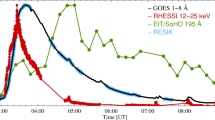Abstract
Soft X-ray data for prolonged flares in subgiants in RS CVn binary systems and some other active late-type stars (AB Dor, Algol) are analyzed. During these nonstationary events, a large amount of hot plasma with temperatures exceeding 108 K exists for many hours. Numerical simulations of gas-dynamical processes in the X-ray source—giant loops—can yield reliable estimates of the plasma parameters and flare-source size. This confirms that such phenomena exist while considerable energy is supplied to the top part of a giant loop or system of loops. Refined estimates of the flare energy (up to 1037 erg) and scales contradict the widely accepted idea that prolonged X-ray flares are associated with the evolution of local magnetic fields. The energy of the current component of the large-scale magnetic field arising during the ejection of magnetic field by plasma jets or stellar wind is estimated. Two cases are considered: a global stellar field and fields connecting regions with oppositely directed unipolar magnetic fields. The inferred energy of the current component of the magnetic field associated with distortion of the initial MHD configuration is close to the total flare energy, suggesting that large-scale magnetic fields play an important role in prolonged flares. The flare process encompasses some portion of a streamer belt and may propagate along the entire magnetic equator of the star during the most powerful prolonged events.
Similar content being viewed by others
References
A. Maggio, R. Pallavicini, F. Reale, and G. Tagliaferri, Astron. Astrophys. 356, 627 (2000).
M. Güdel, J. L. Linsky, A. Brown, and F. Nagase, Astrophys. J. 511, 405 (1999).
S. Tsuneta, Astrophys. J. 456, 840 (1996).
T. G. Forbes and L. W. Acton, Astrophys. J. 459, 330 (1996).
I. M. Chertok, V. V. Fomichev, A. A. Gnezdilov, and R. Gorgutsa, Sol. Phys. (2001) (in press).
Z. Svestka, F. Farnik, H. S. Hudson, et al., Sol. Phys 161, 331 (1995).
R. C. Canfield, H. S. Hudson, and D. E. McKenzie, Geophys. Res. Lett. 26, 627 (1999).
H. Wang, P. R. Good, C. Dencera, et al., Astrophys. J. 536, 971 (2000).
P. A. Sturrock, Nature 211, 695 (1966).
R. A. Kopp and G. W. Pneuman, Sol. Phys. 50, 85 (1976).
K. V. Getman and M. A. Livshits, Astron. Zh. 76, 704 (1999) [Astron. Rep. 43, 615 (1999)].
A. McAllister, M. Dryer, P. McIntosh, and H. Singer, J. Geophys. Res. 101(A6), 13497 (1996).
S. L. Cully, G. Fisher, M. J. Abbott, and O. H. W. Siegmund, Astrophys. J. 435, 449 (1994).
M. M. Katsova, J. Drake, and M. A. Livshits, Astrophys. J. 510, 986 (1999).
K. V. Getman and M. A. Livshits, Astron. Zh. 77, 295 (2000) [Astron. Rep. 44, 255 (2000)].
G. Peres, R. Rosner, S. Serio, and G. S. Vaiana, Astrophys. J. 252, 791 (1982).
R. M. Betta, G. Peres, F. Reale, and S. Serio, Astron. Astrophys., Suppl. Ser. 122, 585 (1997).
R. Osten and A. Brown, Astrophys. J. 515, 746 (1999).
R. Pallavicini and G. Tagliaferri, Palermo Astronomy Preprint No. 4 (1998).
V. G. Graffagnino, D. Wonnacott, and S. Schaeidt, Mon. Not. R. Astron. Soc. 275, 129 (1995).
F. Favata, J. H. M. M. Schmitt, G. Micela, et al., Astron. Astrophys. 362, 628 (2000).
T. Tsuru, K. Makishima, and T. Ohashi, Publ. Astron. Soc. Jpn. 41, 679 (1989).
R. Pallavicini, G. Tagliaferri, and L. Stella, Astron. Astrophys. 228, 403 (1990).
R. Mewe, J. S. Kaastra, and D. A. Liedahl, Legacy 6, 16 (1995).
G. H. J. Van Den Oord and F. Zuccarello, in Stellar Surface Structure, Ed. by K. G. Strassmeier and J. Linsky (Kluwer, Dordrecht, 1996), p. 433.
M. M. Katsova and M. A. Livshits, in Proceedings of the 11th Cambridge Workshop on Cool Stars, Stellar Systems and the Sun, 2001, Ed. by R. J. G. Lopes, R. Rebolo, and M. R. Z. Osorio; Astron. Soc. Pac. 223, 979 (2001).
S. Kouchmy and M. A. Livshits, Space Sci. Rev. 61, 393 (1992).
F. A. Ermakov, Physics of Solar Activity [in Russian], Ed. by E. I. Mogilevskii (Nauka, Moscow, 1988), p. 25.
I. S. Veselovskii, Geomagn. Aeron. 34(6), 1 (1996).
I. S. Veselovsky, in Proceedings of the 9th European Meeting on Solar Physics, Magnetic Fields and Solar Processes, Florence, 1999, ESA SP-448, p. 1217.
T. N. Tarasova, S. I. Plachinda, and V. V. Rumyantsev, Astron. Zh. 78, 550 (2001) [Astron. Rep. 45, 475 (2001)].
B. V. Somov and S. I. Syrovatskii, in Neutral Current Layers in Plasma [in Russian] (Nauka, Moscow, 1974), Tr. Fiz. Inst. Akad. Nauk SSSR, Vol. 74, p. 14.
Author information
Authors and Affiliations
Additional information
__________
Translated from Astronomicheski\(\overset{\lower0.5em\hbox{$\smash{\scriptscriptstyle\smile}$}}{l} \) Zhurnal, Vol. 79, No. 4, 2002, pp. 364–376.
Original Russian Text Copyright © 2002 by I. Livshits, M. Livshits.
Rights and permissions
About this article
Cite this article
Livshits, I.M., Livshits, M.A. Origin of prolonged X-ray flares on active late-type stars. Astron. Rep. 46, 327–338 (2002). https://doi.org/10.1134/1.1471397
Received:
Issue Date:
DOI: https://doi.org/10.1134/1.1471397



